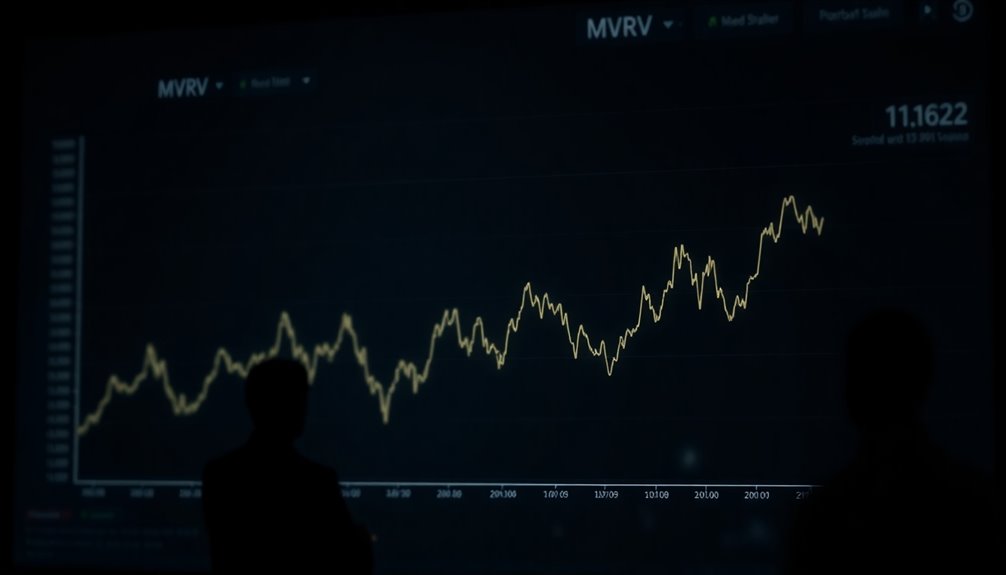Bitcoin's short-term MVRV has recently normalized, indicating a shift in market dynamics that's crucial for you to understand. The MVRV ratio helps assess whether Bitcoin is overvalued or undervalued by comparing market value to its realized value. With current readings suggesting stability, this signals a potential return to fundamental valuations. Factors like limited supply, changing investor sentiment, and external events all play a role in these fluctuations. As the market stabilizes, it could mean changes in your investment strategies. There's more to these trends and their implications that you might find intriguing.
Key Takeaways
- Recent normalization of Bitcoin's short-term MVRV suggests stabilization in prices and reduced speculative trading activities.
- Market value fluctuations are influenced by demand drivers like institutional interest and retail participation, impacting MVRV readings.
- Emotional trading and herd mentality can lead to volatility, making MVRV a crucial indicator for assessing market sentiment.
- Historical MVRV spikes often precede market corrections, indicating the importance of monitoring MVRV trends for investment strategies.
- Future market conditions and regulatory changes will continue to impact MVRV, necessitating ongoing analysis for effective risk management.
Market Value to Realized Value

Understanding the relationship between market value and realized value is crucial for Bitcoin investors. Market value is determined by multiplying Bitcoin's current price by the number of coins in circulation. In contrast, realized value reflects the aggregate worth of all coins based on their last transaction price. The MVRV, or Market Value to Realized Value ratio, is calculated by dividing market value by realized value. A high MVRV, like 2.2, indicates significant profit potential, while an MVRV of 1.0 shows a break-even point. Recognizing these values helps you gauge market conditions—high values may signal overvaluation, and low values can indicate undervaluation, providing strategic insights into when to buy or sell your Bitcoin assets. Additionally, historical extremes in MVRV patterns correlate with major market cycle tops and bottoms, offering further context for investment decisions.
Market Dynamics and MVRV

While the MVRV ratio serves as a valuable tool for assessing Bitcoin's market conditions, its implications are deeply intertwined with underlying market dynamics.
With Bitcoin's total supply capped at 21 million, growing demand, especially from retail and institutional investors, often drives price increases. Events like halving reduce new Bitcoin issuance, tightening supply and further fueling demand. The fixed supply of Bitcoin creates scarcity, which can lead to higher prices as demand increases. Additionally, the potential for Bitcoin to act as a hedge against inflation makes it an attractive asset for investors during economic uncertainty.
Investor sentiment, shaped by media and speculation, can also sway market behavior, as seen during bull and bear cycles reflected in MVRV trends.
Moreover, regulatory news and geopolitical instability can influence demand, while liquidity from trading volumes and institutional adoption plays a crucial role in price stability.
Understanding these dynamics helps you interpret MVRV's significance in the current market landscape.
MVRV Ratio Calculation Process

To calculate the MVRV ratio, you'll need to focus on two key components: Market Value and Realized Value. The formula is straightforward: MVRV = Market Value / Realized Value.
Market Value is determined by multiplying the current price by the total number of coins in circulation. In contrast, Realized Value reflects the total cost paid by investors, analyzed from blockchain data to exclude unrealized gains or losses.
For example, if Bitcoin's price is $50 and there are 1,000,000 coins, the Market Value would be $50,000,000. If the average cost basis is $30, then the Realized Value totals $30,000,000, resulting in an MVRV of 1.67. This calculation helps gauge market cycles and valuation, providing insights into unrealized profits that influence investor behavior.
Pros and Cons Overview

When you examine the pros and cons of using Bitcoin's short-term MVRV, you'll find that it offers valuable insights while also presenting certain limitations.
On the plus side, it provides real-time data, helping you gauge current market conditions and identify investor behavior. It can effectively highlight market extremes, pinpointing potential tops and bottoms. Additionally, the MVRV ratio uses on-chain data, which enhances its reliability as a market indicator.
However, it's not great for short-term trading predictions, as it requires a broader perspective. External factors, like interest rate changes, can skew its effectiveness, and you'll need a solid understanding of blockchain analytics to use it properly.
Lastly, it can generate false signals, so it's essential to pair it with other indicators for a more accurate analysis.
Market vs. Realized Value

Market value represents the current financial worth of all bitcoins in circulation, calculated by multiplying the price by the total number of coins. This value can fluctuate dramatically, driven by market emotions like fear and greed. In contrast, realized value reflects the cost basis of all available bitcoins, determined by the price at which each bitcoin last moved. It provides a weighted average that accounts for both active and dormant coins. The distinction between market value and realized value is crucial for understanding crypto valuation metrics in assessing Bitcoin's economic significance.
Market Volatility Concerns

While market volatility is a hallmark of the cryptocurrency landscape, it's particularly pronounced in Bitcoin due to a variety of factors. Positive or negative news can swiftly sway prices, amplifying emotional trading driven by fear or greed. You might notice that herd mentality often results in dramatic price swings, as investors react to fear, uncertainty, and doubt (FUD). Regulatory changes can also trigger significant shifts; a new policy can foster confidence or provoke panic. Additionally, Bitcoin's limited supply means sudden demand changes can lead to sharp price movements. Large holders, or "whales," can manipulate trends, while insufficient liquidity exacerbates these fluctuations. Behavioral factors such as nominal price illusion also contribute to volatility, as they influence how investors perceive price movements. Together, these elements create a volatile environment that every investor should navigate cautiously.
MVRV Ratio Approaches Historical Average

As the MVRV ratio approaches its historical average, you might notice a shift in market dynamics that signals potential stabilization.
This ratio, calculated by dividing the market value of Bitcoin by its realized value, serves as a profit and loss indicator. When the MVRV hovers around the mean, it suggests a balance between current market valuations and historical purchase prices. Deviations from this average can create volatility; high values often lead to profit-taking, while low values may trigger capitulation.
Thus, as the MVRV normalizes, it may reduce immediate selling pressure, presenting potential buying opportunities. MVRV Z-Score analysis can further enhance your understanding of market conditions during this normalization phase.
Understanding this relationship helps you assess market sentiment and make informed investment decisions in the Bitcoin landscape.
Monitor MVRV Trends Regularly

Monitoring MVRV trends regularly is crucial for staying ahead in the dynamic Bitcoin market. By keeping an eye on the MVRV ratio, you can assess whether Bitcoin is overvalued or undervalued relative to its realized value.
High MVRV values often signal potential market tops, while low values could indicate capitulation events. Recognizing these patterns helps you make informed decisions about buying or selling.
Additionally, understanding the relationship between MVRV and market sentiment can guide your investment strategy. Combining MVRV with other indicators enhances your analysis, allowing you to navigate market volatility effectively. MVRV provides insights into whether an asset is overvalued or undervalued.
Frequently Asked Questions
How Does Bitcoin's MVRV Impact Investor Sentiment?
Bitcoin's MVRV significantly impacts your sentiment as an investor.
When MVRV is high, you might feel cautious, anticipating a potential market correction. This overvaluation can lead you to consider selling.
Conversely, a low MVRV suggests undervaluation, making you optimistic about buying opportunities.
Your decisions are influenced by these ratios, reflecting immediate market perceptions and driving your behavior, whether to hold, sell, or buy based on perceived value and potential future gains.
What Are the Historical Trends of MVRV Fluctuations?
When you look at historical MVRV trends, you'll notice high values often indicate market euphoria, signaling potential price tops and corrections.
Conversely, low values suggest undervaluation and buying opportunities, typically marking market bottoms.
As an investor, recognizing these fluctuations helps you navigate market cycles, understanding when to buy or sell based on whether the market is overbought or oversold.
Keeping an eye on these trends can enhance your investment strategy.
How Can MVRV Be Used in Trading Strategies?
You can use the MVRV ratio in your trading strategies by monitoring its fluctuations.
When MVRV is below 1, consider buying, as it often signals undervaluation. Conversely, if it rises above 3.7, it might be time to sell, locking in profits before potential corrections.
Combining MVRV with other indicators enhances your decision-making, allowing you to identify optimal entry and exit points effectively.
This approach helps you manage risk and capitalize on market trends.
Are There Alternative Metrics to MVRV for Analysis?
Absolutely, there're several alternative metrics you can use for analysis.
Take a look at Net Unrealized Profit/Loss (NUPL) to gauge market profitability. You might also explore the Fear and Greed Index, which captures investor sentiment effectively.
Coin Days Destroyed (CDD) provides insights into market participation, while Spent Output Profit Ratio (SOPR) helps evaluate profitability when coins are spent.
Each metric offers unique perspectives, enriching your overall market analysis.
How Does MVRV Relate to Overall Market Cycles?
MVRV, or Market Value to Realized Value, directly relates to overall market cycles by indicating potential tops and bottoms.
When MVRV values are high, it suggests the market is overvalued, often signaling a peak. Conversely, low MVRV values point to undervaluation, indicating a market bottom.
Conclusion
In the ever-evolving world of Bitcoin, understanding the MVRV ratio is crucial for making informed decisions. As the saying goes, "forewarned is forearmed." By keeping an eye on market dynamics and the MVRV trends, you can better navigate the volatility and capitalize on opportunities. Remember, the market can shift quickly, so staying updated will help you act wisely when the moment arises. Embrace the knowledge and be ready to seize your next move!









